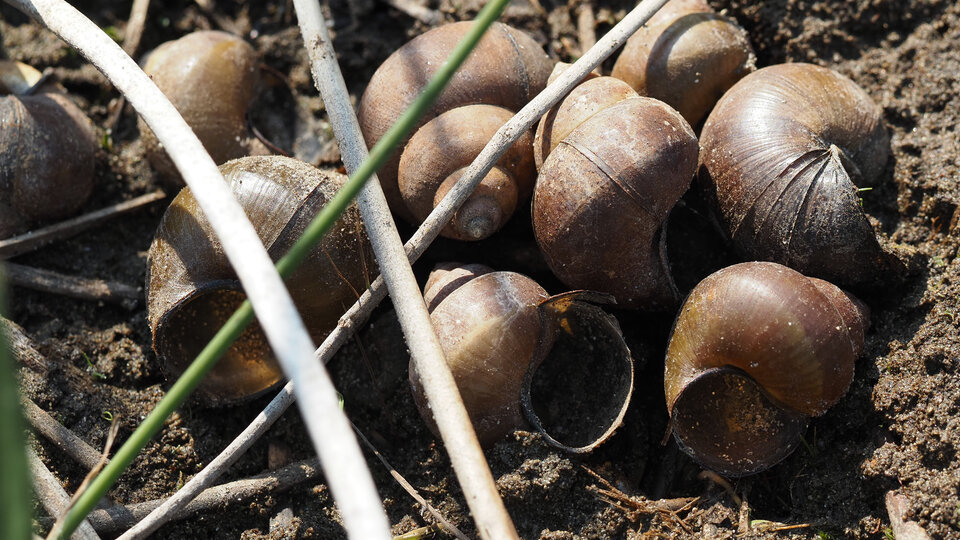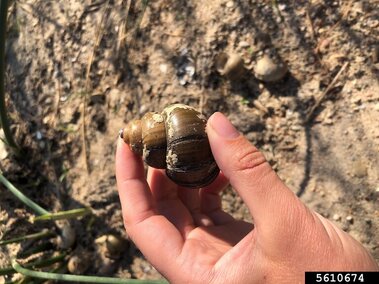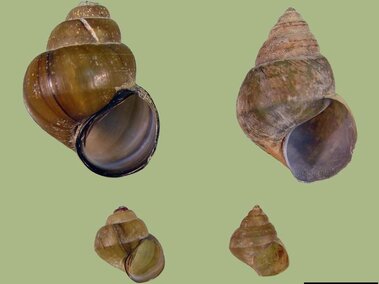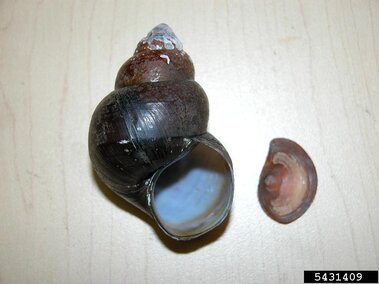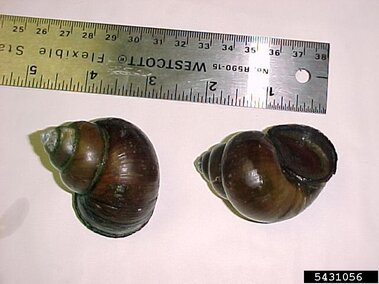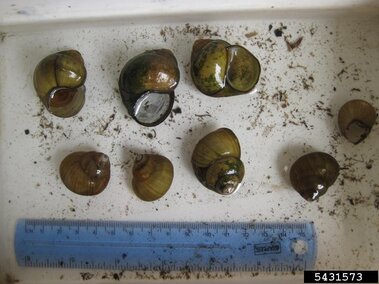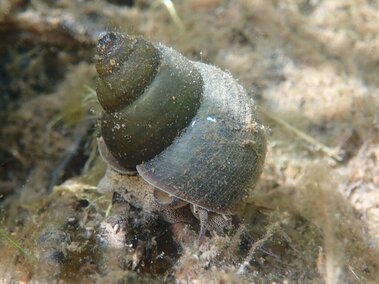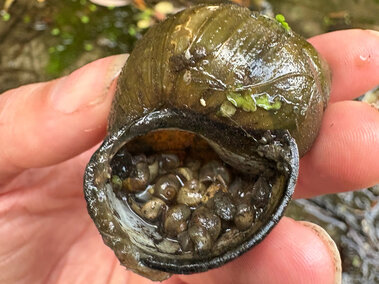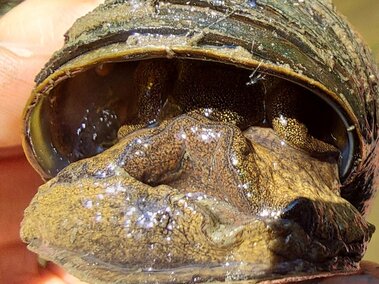General Information
Species Name: Cipangopaludina chinensis
Also Known As: Asian applesnail, Asian freshwater snail, Chinese applesnail, Chinese mystery snail, Chinese mysterysnail, Oriental mysterysnail
Family: Viviparidae (Mystery Snail)
Life Span: 3-5 years
Life Cycle: They are called “mystery” snails because females give birth to young, fully developed snails that suddenly and “mysteriously” appear. The trapdoor snail reaches sexual maturity after only 6-12 months. Throughout June to late October in their non-native North American range, these mature females reproduce numerous times, with just a single female capable of producing an average of 25-35 offspring per brood. In addition, trapdoor snails demonstrate increased reproduction in warmer water temperatures (around 27°C), while snails held at cooler water temperatures (12°C or below), displayed limited or discontinued reproduction.
Origin: Southeast Asia to Japan and eastern Russia
Injurious: No
Category 3: Established Aquatic Invasive Species
Why Are They Invasive?
The large relative size, multiple feeding mechanisms (consuming algae & filter feeding for plankton), resistance to predation, and ability to withstand environmental stressors, such as fluctuating water temperatures and dry conditions enable the trapdoor snail to easily out-compete native freshwater gastropods and mollusks. In turn, this ability to out-compete native species negatively affects the biodiversity of aquatic ecosystems, and alters food webs by decreasing the population sizes of common mollusk prey species for predators such as otters, muskrats, waterfowl, fishes, etc. In addition, the trapdoor snail alters nutrient cycling by excreting large amounts of fecal matter, which can alter the nitrogen and phosphorous cycling within aquatic ecosystems and can cause impacts on bacterial, algal, and zooplankton communities.
Like invasive zebra mussels and quagga mussels, the presence of the trapdoor snail in freshwater aquatic ecosystems can lead to water quality issues such as algal blooms. This effect is produced by the high filtration rate of plankton the trapdoor snail displays when feeding. The absence of plankton and free-floating detritus in the water produces elevated water clarity, which may seem like a positive side effect, but leads to excess sunlight penetration, generating excess photosynthesis, and ultimately results in overrun algal blooms. trapdoor snails also have the potential to be a vector for parasites and diseases and have been reported to clog water intake pipes. Their empty large decaying shells can also wash up on shore, discouraging recreational activities, and could create hazards if stepped on.
What Do They Look Like?
Trapdoor snails are small animals with a coiled spiral shell. They grow up to three inches tall and are olive colored. The shell opening is on the right when the shell is pointed up. They have an operculum ("trapdoor") covering the opening, which is missing when the snail is dead, and the shell is empty.
Photos
Where Do They Live?
The trapdoor snail grazes on lake and river bottom material. Prefers shallow, quiet waters of ponds, marshes, lakes, canals, ditches and slow-moving rivers; on vegetation or soft, muddy and sandy-bottomed areas.
How Do They Spread?
The species is commonly imported and sold by the aquarium trade, leading to the potential for illegal release into the wild. It was brought to California in 1892 as a food source and found in Massachusetts in 1915.
How Do I Control Them?
Contact the Nebraska Game and Parks Commission to determine appropriate control methods. To prevent their spread and introduction into your waterbodies:
CLEAN your watercraft, trailer, angling gear and other equipment. Remove all aquatic vegetation and animal species from your equipment.
DRAIN your watercraft at the ramp by removing the boat plug and draining all live wells and ballast tanks.
DRY your watercraft, trailer and other equipment for at least 7 days before visiting another waterbody.
DON'T DUMP BAIT. Dispose of bait by emptying bait buckets on dry land, away from waterbodies or in a trash receptacle. Moving a live organism from one waterbody to another is illegal, even if you are planning to use the organism as bait.
DON'T LET IT LOOSE. Do not release or transport exotic or non-native fish species to new ecosystems. It is unlawful to release any aquatic species into a waterbody other than the one from which it was harvested. Doing so can promote the spread of AIS.
What Should I Do If I See Them in Nebraska?
If you see trapdoor snails in Nebraska, you should report them to the Nebraska Game and Parks Commission's Aquatic Invasive Species (AIS) Program using their AIS Report Form. For guidance on what information to include in your report, check out our reporting tips.
References and More Information
Center for Invasive Species and Ecosystem Health
Midwest Invasive Species Information Network
Minnesota Department of Natural Resources
Missouri Department of Conservation
Nebraska Game and Parks Commission
Smithsonian Environmental Research Center
Summary of Species Currently Listed as Injurious Wildlife under (18 U.S.C. 42) Lacey Act
University of Wisconsin Sea Grant
